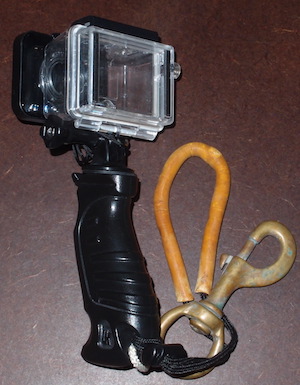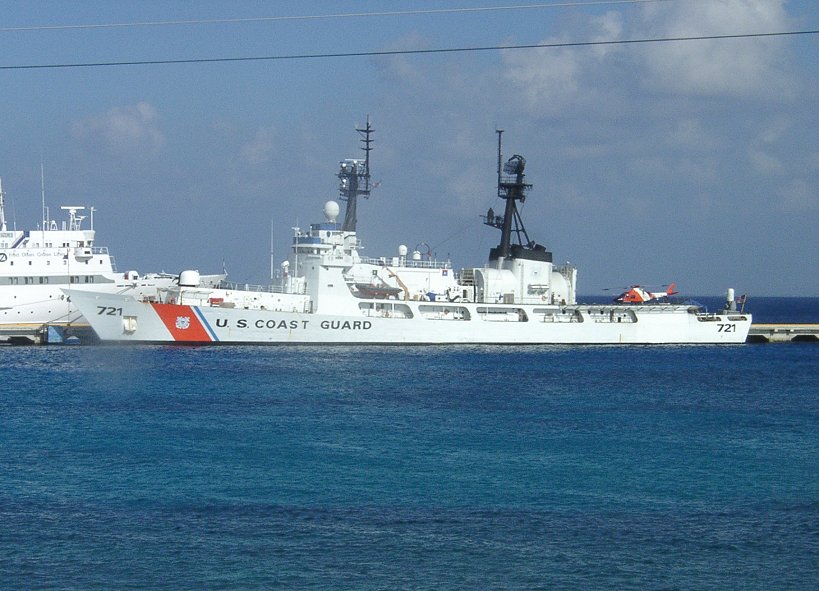Underwater Video
One day, when conditions were marginal for still photography, I put my little camera in video mode, just to see what it could do. Was I ever surprised at the result! Here is the first underwater video I ever shot:
This was originally shot at the highest quality settings that the camera had - 640x480 resolution, 30 frames per second. The camera offers no other controls - just start and stop - so shooting is pretty much a no-brainer.
You'll notice two things about the video above. The first is that it is unlit. I have no video lights that could possibly light up a scene as wide and deep as you see here, and no intention of spending thousands of dollars on such a setup. The obvious benefit of shooting natural light is that you do not trap yourself inside the small area that you can illuminate. Thus, I can capture a shipwreck in recognizable form, when otherwise I might have nothing but a lot of (well-lit) sea anemones.
The downside of this is the lack of color - most everything is green. The best solution to this problem can also be free - have a buddy pick out colorful details with his dive light. It is also possible to shoot strobe-lit stills in between videos.
The second thing you'll notice about the video is the slight distortion and "vignetting" or black corners that goes along with the use of the wide-angle lens. The ability to get closer to your subject, and lessen the amount of murk in your shot, is a worthwhile trade-off. The vignetting could be avoided by zooming the camera slightly inside the housing, but I think it is better to leave it full-wide and treat the problem later, in production.
When shooting video, it is important to hold the camera steady and move slowly. Don't forget to shoot lead-ins and lead-outs for every scene - these can be removed later if not needed. Generally, you will shoot in one of three ways:
- Hold steady on a subject that is doing something interesting, such as another diver.
- Pan slowly across a wide scene by pivoting in place.
- Move smoothly through a scene by swimming or drifting, revealing new details as they come into view.
The last option is by far the most difficult and can become very tiring for longer shots. Combinations of all three methods can give nice results, such as pan around 180 degrees, and then take off swimming. Don't be afraid to re-shoot something if you think it didn't come out - pixels are free.
GoPros and GoPro Garbage
The GoPro really revolutionized video. The camera shoots reasonably good HD video and can take stills, and uses a waterproof housing that fits in your pocket. The problem with GoPros is the way people use them. Most people stick it on their head and turn it on before they jump in the water. The camera is inevitably pointed too low or too high, usually too low. Then they record every jerk and twitch they make, and then they upload the whole thing unedited to YouTube. Or worse, they add an awful soundtrack, and then upload the whole thing unedited to YouTube.
The result is GoPro Garbage. I can't even watch these clips - I get motion-sick from all the jerking around. I also get frustrated on the rare occasions when something interesting comes on the screen, but it is half cut off and jerking all over the place and you can barely make it out. Fortunately, most of this trash consists of divers in the boat staring at their fins, and divers in the water staring at each other. There is rarely anything interesting, so you don't have to feel you're missing anything by simply skipping the whole mess. What a waste of disk space, but YouTube doesn't seem to mind.
From time to time I search for videos that I might want to add to the website. I never find any. The GoPro has basically destroyed the art of underwater video.
If you make GoPro Garbage, please stop.
No one is watching it.
No one can.

You can get good results with a GoPro. You need to treat it like a real video camera. First, get or make a proper handle for it, so you can hold it steady and work the controls with your other hand. Then, get the accessory monitor back for it, so you can see what the hell you are shooting. If a special underwater housing or port is available for your model, get it. Don't forget a lanyard and clip. Also, there is no law against using video lights with a GoPro.
In or out of the water, the trick to shooting good video is simple - just three words: SLOW AND STEADY. Pan slowly, swim slowly, don't be afraid to shoot a scene without moving the camera at all. Always hand-hold the camera as steady as you can. Brace it against solid object when possible. This is the only time I will ever tell someone to watch TV, but do that. Put on a movie, not a staged sitcom, and try to imagine what they are doing with the camera. It's not twitching all over the place, most of the time it is not moving at all, and when it does, it moves slowly. Except for the 'Blair Witch Project', which is simply GoPro Garbage on a larger scale.
You can shoot video in much poorer conditions than still photography. The trick is what I call 'stretching the visibility'. First of all, if it's really bad, just hang it up, that is what the clip is for. But if you have 10-15 feet of viz, you can 'stretch' that by panning and swimming. For example, if you pan across 90 degrees in 15-foot viz, and the lens has a field of view of 60 degrees, you can effectively capture a 29-foot scene. Swimming has an even greater effect, you can stretch the viz as far as you can swim. However, it is more difficult to get steady results while swimming, and also more difficult to control yourself at the slow speeds needed for video.
Finally, EDIT your videos. The five minutes you spent staring at your fins, you can cut that part out. Climbing up the boat ladder - ditto. I've climbed up plenty of boat ladders myself, I don't need to watch you do it. Cut it down to just the best parts, and try to shoot something that's interesting. I am surprised if I can produce a 6-minute video from a 30-minute dive. Better software can adjust color and exposure to bring out details and do neat transitions between cuts. As far as soundtracks go, don't assume everyone shares your love of death metal, or techno, or any other kind of music. Inoffensive Musak works best, or silence, or your Darth Vader breathing, if you don't want to narrate it.
It's not hard to produce good video with a GoPro. The first step is to pry it off your forehead.
Software
This is where the real work begins. After shooting your video, you'll want to edit it into something presentable, with some kind of plot or sequence, titles, transitions, narration, and soundtrack ( other than Darth Vader noises. ) Both Windows and Mac come with very basic video editing software built-in that you can start with.
All video editing software seems to suffer from a steep learning curve and some program instability. Typically, you'll spend hours building a project, just to find out that for no reason, it won't render, often just the last few seconds. This was especially true on Windows. There is a reason most movie editing is done on Macs.
One thing that is important when "rendering" video is to always render to a different physical disk than your software is running from; that is to say, a second hard drive. A USB2 drive is perfect for this; a large memory card will do in a pinch. This makes the process both faster and more reliable. Rendering directly to an optical disk is a good way to make coasters; render a disk image to a hard drive, and then burn it to CD or DVD once it is confirmed good.
When editing the video above, I have zoomed in slightly to reduce "vignetting" - the black corners caused by the wide-angle lens. I also pushed up the contrast and tweaked the brightness as needed. You can also alter the hue to something less green if desired.
That's all I've learned about video so far, with my little "jackass" video camera.

